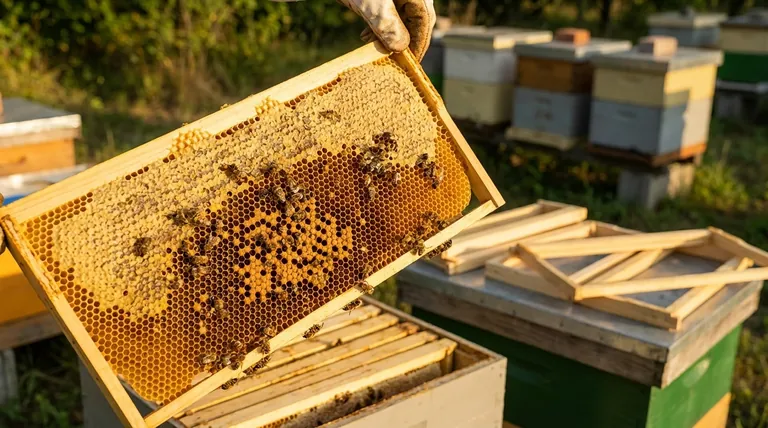In short, frames and combs are the fundamental building blocks of a modern beehive. The comb is the waxy structure bees build to raise their young (brood) and store food (honey and pollen), while the frame is the wooden or plastic rectangle that holds the comb, making the entire hive manageable for the beekeeper.
The critical insight is that frames impose an orderly structure on the bees' natural instincts. This innovation allows beekeepers to inspect, manage, and harvest from the hive without destroying the colony, creating a symbiotic relationship between bee and keeper.

The Role of the Comb: The Bee's Living Space
At its core, the beeswax comb is the heart of the colony. It serves two essential, life-sustaining purposes that are entirely dictated by the bees themselves.
The Nursery for Brood Rearing
The queen bee lays her eggs in the individual hexagonal cells of the comb. These cells serve as a nursery where the eggs hatch into larvae, develop into pupae, and eventually emerge as adult bees. The comb is the colony's cradle.
The Pantry for Food Storage
Worker bees use other cells in the comb to store food. They deposit nectar, which they dehydrate to create honey, and pack pollen into cells to create "bee bread." These food stores are the colony's energy source, crucial for surviving winter and feeding their young.
The Role of the Frame: The Beekeeper's Management Tool
While the comb is the bees' domain, the frame is the tool that makes modern beekeeping possible. It provides a rigid structure that contains the delicate comb.
Providing Structure and Guidance
Frames guide the bees on where to build their comb. Without them, bees would attach comb to the hive walls and to each other, creating a chaotic, immovable mass that could not be inspected.
Enabling Non-Destructive Inspections
The most significant purpose of the frame is to allow for easy removal and inspection. A beekeeper can lift out a single frame to check the queen's health, look for signs of disease, or assess food stores without tearing the hive apart.
Facilitating Honey Harvest and Expansion
Frames make honey harvesting efficient and sustainable. Beekeepers can remove frames full of honey, extract it, and then return the empty comb to the bees, saving them the immense energy required to build new wax. They can also add new frames to give a growing colony more space to expand.
Understanding the Key Principle: "Bee Space"
The entire system of removable frames works because of a principle known as bee space. This is a precise gap (roughly 1/4 to 3/8 of an inch) that bees will naturally leave clear as a walkway.
The Genius of Modern Hives
Modern beehives are built with exact measurements that maintain this "bee space" around every part of every frame. Because this space is respected, the bees do not weld the frames to the hive box or to each other with wax and propolis.
What Happens Without Bee Space
If the gap is too large, bees will fill it with comb. If it's too small, they will seal it with propolis (a resinous bee glue). Frames are designed to prevent both outcomes, ensuring they remain easy to move.
Making the Right Choice for Your Goal
The type of frame and foundation (the sheet of wax or plastic that gives bees a building guide) you use can be tailored to your beekeeping philosophy.
- If your primary focus is maximum honey production: Using frames with a pre-made foundation encourages bees to build straight combs quickly, accelerating honey storage.
- If your primary focus is natural beekeeping: Choosing foundationless frames allows bees to build comb with cell sizes they determine naturally, though it requires more monitoring to ensure straight construction.
- If your primary focus is durability and ease of use: Integrated plastic frames with a foundation coating are robust, simple to handle, and less prone to damage during extraction.
Understanding these components is the first step toward becoming an effective and responsible beekeeper.
Summary Table:
| Component | Purpose for Bees | Purpose for Beekeeper |
|---|---|---|
| Comb | Nursery for brood; Pantry for honey & pollen | The colony's living space and food source |
| Frame | Structure to build comb upon | Tool for inspection, management, and honey harvest |
| Bee Space | Natural walkway (1/4-3/8 inch) | Prevents comb/propolis attachment, allows frame removal |
Ready to build a more productive and manageable apiary?
At HONESTBEE, we supply commercial apiaries and beekeeping equipment distributors with the high-quality, durable frames and foundations that are essential for efficient hive management. Whether your focus is on maximizing honey production, natural beekeeping, or operational durability, our wholesale-focused operations provide the reliable equipment you need to succeed.
Contact HONESTBEE today to discuss your wholesale needs and equip your operation with the foundation for success.
Visual Guide

Related Products
- Wooden Bee Hive Frames for Beekeeping and Wholesale
- Copper Bee Frame Eyelets for Beekeeping
- HONESTBEE Professional Long Handled Hive Tool with Precision Cutting Blade
- Heavy-Duty Nylon Beehive Hive Strap with Stainless Steel Cinch Buckle
- Professional Galvanized Hive Strap with Secure Locking Buckle for Beekeeping
People Also Ask
- What is the role of oxalic acid in plants? A Key to Plant Defense and Internal Regulation
- What types of beehive frames are compatible with the honey press? A Guide to Crush-and-Strain Extraction
- Will honey bees clean up old frames? A Guide to Safe and Efficient Frame Reuse
- What are the standard sizes of frames used in Langstroth hives? Choose the Right Frame for Your Apiary
- What are the primary uses of different Langstroth frame sizes? Optimize Your Hive for Health & Honey



















